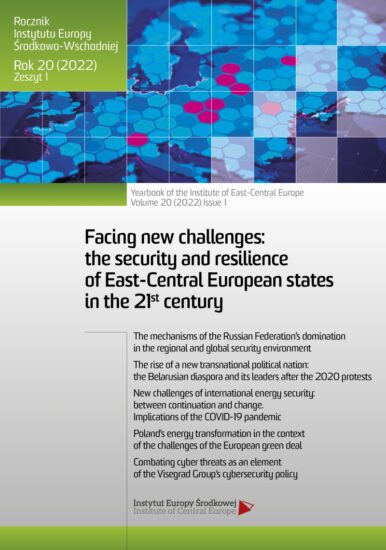The mechanisms of the Russian Federation’s domination in the regional and global security environment
Antoniades A., From ‘Theories of Hegemony’ to ‘Hegemony Analysis’ in International Relations, Sussex 2008, https://core.ac.uk/download/pdf/2709786.pdf.
Banasik M., Wojna hybrydowa w teorii i praktyce Federacji Rosyjskiej, “Bellona” 2015, no. 4.
Berzins J., Russia’s New Generation Warfare in Ukraine: Implications for Latvian Defense Policy, Policy Paper 2, Center for Security and Strategic Research, Riga 2014.
Brzezinski Z., The Grand Chessboard: American Primacy and its Geostrategic Imperatives, New York 1998.
Chuev V., Mikhailov Yu.B., Forecasting in Military Affairs, Moscow 1975.
Clark M., The Russian View of Future War: Unconventional, Diverse, and Rapid, Institute for the Study of War, Washington 2020.
Douglass J.D., Hoeber A.M., Selected Readings From Military Thought 1963-1973, “Studies of Communist Affairs” 1976, vol. 5, part II.
Edmonds J., Bendett S., Russian Battlefield Awareness and Information Dominance: Improved Capabilities and Future Challenges, Strategy Bridge, 26 February 2019, https://thestrategybridge.org/the-bridge/2019/2/26/russian-battlefield-awareness-and-information-dominance-improved-capabilities-and-future-challenges.
Fedyk N., Russian “New Generation” Warfare: Theory, Practice, and Lessons for U.S. Strategists, Small War Journals, 5 April 2017, https://smallwarsjournal.com/jrnl/art/russian-%E2%80%9Cnew-generation%E2%80%9D-warfare-theory-practice-and-lessons-for-us-strategists-0.
Joint Vision 2020, U.S. Department of Defense, Washington 2000.
Kofman M., Fink A., Russian Military Strategy: Core Tenets and Operational Concepts, Washington 2021.
Korybko A., Hybrid Wars: The Indirect Adaptive Approach to Regime Change, Moscow 2015.
Ledyaev V., Domination, Power and Authority in Russia: Basic Characteristics and Forms, “Journal of Communist Studies and Transition Politics” 2008, no. 24(1), pp. 17-36, https://www.researchgate.net/publication/233014878_Domination_Power_and_Authority_in_Russia_Basic_Characteristics_and_Forms/citations.
Łoś R., Siła współczesnych państw. Ujęcie teoretyczne, “Przegląd Politologiczny” 2018, no. 2.
Lynch III T.F., Strategic Assessment 2020. Into a New Era of Great Power Competition, Washington 2020.
Majaski Ch., Comparing a Dominant Strategy Solution vs. Nash Equilibrium Solution, Investopedia, 13 June 2021, https://www.investopedia.com/ask/answers/071515/what-difference-between-dominant-strategy-solution-and-nash-equilibrium-solution.asp.
Mazarr M.J., Blake J.S., Understanding the Emerging Era of International Competition. Theoretical and Historical Perspectives, Santa Monica 2018.
Minkina M., Kaszuba M., Color Revolutions as a Threat to Security of the Russian Federation. An Analysis of Russian Perspective, “Torun International Studies” 2021, vol. 1, no. 14.
Nye Jr. J. S., How Sharp Power Threatens Soft Power. The Right and Wrong Ways to Respond to Authoritarian Influence, Foreign Affairs, 24 January 2018, https://www.foreignaffairs.com/articles/china/2018-01-24/howsharp-power-threatens-soft-power.
Nye Jr. J.S., The Paradox of America Power: Why the World’s Only Superpower Can’t Go it Alone, New York 2002.
Oliker O., Russian Influence And Unconventional Warfare Operations In The “Gray Zone”: Lessons From Ukraine, Washington 2017.
Panda A., Chinese, Russian, South African Navies Conduct Trilateral Naval Exercises. The exercise was the first of its kind, The Diplomat, 27 November 2019, https://thediplomat.com/2019/11/chinese-russian-south-african-navies-conduct-trilateral-naval-exercises/.
Polyakova A., Boulègue M., The Evolution of Russian Hybrid Warfare, Washington 2021.
Putin W., Meeting of the Valdai International Discussion Club, 22 October 2015, http://en.kremlin.ru/events/president/news/50548.
Radin A., Reach C., Russian Views of the International Order, Santa Monica 2017.
Russell M., Russia’s armed forces. Defence capabilities and policy, Brussels 2021.
Ryabchuk V.D. Nichipor V.I., On the Roles and Place of Forecasting and Anticipation in the System of Operational and General Work Planning, “Military Thought” 2007, no. 10, pp. 61-67.
Serzhantov A., Mazhuga S., Wars of the future: what will they be like?, “Independent Military Review” 2019, no. 35, https://nvo.ng.ru/concepts/2019-09-27/3_1063_futurewars.html.
Shashkov S., The theory of ‘manageable chaos’ put into practice, Ministry of Foreign Affairs of the Russian Federation, 1 March 2011, https://en.interaffairs.ru/article/the-theory-of-manageable-chaos-put-into-practice/.
Special Forces Unconventional Warfare, Fort Bragg 2010, https://nsnbc.files.wordpress.com/2011/10/special-forces-uw-tc-18-01.pdf.
The Soviet Army: Operations and Tactics, Field Manual No. 100-2-1, Washington 1984.
Thomas T., Russia’s Forms and Methods of Military Operations The Implementers of Concepts, “Military Review”, May-June 2018, https://www.armyupress.army.mil/Portals/7/military-review/Archives/English/Thomas-Russias-Forms-Methods.pdf.
Thomas T.L., Russian Forecasts of Future War, “Military Review”, May-June 2019, https://www.armyupress.army.mil/Portals/7/military-review/Archives/English/MJ-19/Thomas-Russian-Forecast.pdf.
US-Russian spat over bombers landing in Venezuela, BBC News, 11 December 2018, https://www.bbc.com/news/world-latin-america-46522358.
Wall A.E., Demystifying the Title 10-Title 50 Debate: Distinguishing Military Operations, Intelligence Activities, and Covert Action, “Harvard National Security Journal” 2011, vol. 3.
Wallimann I., Tatsis N.C., Zito G.V., On Max Weber’s Definition of Power, “Journal of Sociology” 1977, vol. 13, issue 3.
Wrong D., Power: Its Forms, Bases, and Uses, New Brunswick and London 2002.


